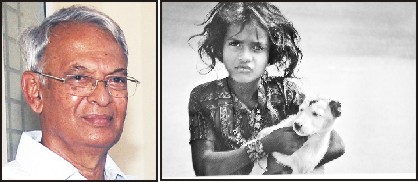Mysore :
No. I am not talking of the Traffic Policeman, the ‘Invisible Lens Man’ one has to be most wary of these days while on the road with a vehicle. While talking of photography, I would like to mention here my visit with my wife to a very small photo exhibition that was held in the city very recently. It was of the pictures taken by Ashvini Ranjan, a man fairly well-known in the social circles of the city for his association with social work. He is a member of the Lions Club and is also associated with Pratham, the well-known NGO. A post-graduate from the University of Mysore, he began his career as a teacher at the University.
Although I have known him well for quite some time now I ‘re-discovered’ him last week as someone interested in photography which holds my interest too. He had written a piece titled ‘The invisible lens man’ in the SOM as a tribute to the legendary photo-journalist T. S. Satyan when he passed away four years ago. Satyan and he were very close friends over many years. He happens to be a regular blogger and having read his writings, I am at a loss to understand why he does not make himself seen in print more often if not on a regular basis, like me.
As I already said, I never knew about his interest, let alone his abilities in the field of photography. The moment I entered the small hall where the expo was held I could not help sensing the presence of my departed friend Satyan. Not just because it was a photo expo but because most of the pictures had the indescribable element that I used to see in Satyan’s shots. When I mentioned this to Ranjan, he immediately blushed in embarrassment and said that it was only my imagination. I agree that imagination plays a very important role in how we appreciate a photograph but as I studied each shot it became clear to me that over his long friendship with the master of monochrome, Ranjan had picked up a bit of his friend’s vision too.
He was conducting this exhibition not so much to exhibit his talent but more so to sell some of his pictures to raise money to help poor kidney failure patients in need of dialysis. Although I saw a few prints marked ‘sold,’ the unsold ones still outnumbered them which seemed a little disturbing to me considering the fact that I was visiting the exhibition on its third and last day. I think Mysoreans should respond in a more generous way to support such causes whenever someone is seen taking an initiative. You may wonder why I have chosen to write about this show long after it is over. Mainly it was because I did not know it was coming, to be able to write about it last Friday. But I still chose to write about it today because I felt that we should have more such events not only to showcase the very good but hidden talents of our citizens but also to encourage them to take up community service through their abilities.
My friend and class fellow, Dr. Ratnakar, who is now settled in Shimoga as a very successful physician, fell in love with photography when he saw me clicking away with my camera while we were both on a tour of Austria some years ago. Upon his return he himself acquired a camera and soon became such a talented nature photographer that he was able to raise nearly three lakh rupees for a temple committee through an exhibition and sale of his prints. While I was at the exhibition I was rather amused to see a few people asking Ranjan what camera he uses. This is a common question most people pose to photographers as most people somehow think that it is only a very a good and expensive camera that can yield good pictures. They can never be more mistaken. It is always the ‘Seeing Eye’ often behind a very ordinary camera which sees the extraordinary and makes great pictures.
The last shot in the exhibition of twenty six pictures showed two burqa-clad ladies with just their eyes visible, seated on a parapet, perhaps waiting for a bus. The picture was just a routine everyday scene on the roadside, quickly captured this time by the photographer as he was waiting at a traffic signal for the light to change. It did not say anything special to the casual observer. But the background did. It said everything that needed to be said. It showed a tattered poster of a Kannada film with the title: ‘Life Ishtene’. I stared hard at the shot and said to my wife, “When we come to think of it, to most women in our country, life is only this much.” Did I need to say anything more?
source: http://www.starofmysore.com / Star of Mysore / Home> Feature Articles / November 15th, 2013
